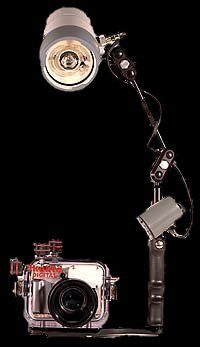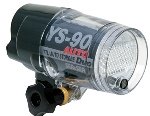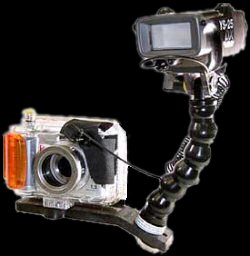|
Underwater Strobe TermsCommon Underwater strobe terms: Before we can start to evaluate underwater digital strobes, we need to understand some common specifications that will assist you in determining which strobe works for you. Guide Number
This is the most technical underwater strobe term,Guide number. When measuring the output of an underwater strobe, its guide number represents the output strength. The higher the guide number, the stronger the strobe’s light output. Most underwater camera manufactures give the underwater guide number and not the land based guide number. Since the water column will absorb some of the strobe’s light, underwater guide numbers are 1/3 the guide number of the land guide number. Once you have the guide number, you can now use this equation to solve for other applications:
(Guide number) = (f-stop) (strobe-to-subject distance).
(strobe-to-subject distance) = (Guide number) / (f-stop)
(f-stop) = (Guide number) / (strobe-to-subject distance)
Now let’s try an example: You want to photography a clown fish inside of an anemone and you select f8 as the f-stop. Your strobe has a guide number of 24. 24/8 equals 3 feet. Your strobe should be 3 feet from the subject. While is rule, will get you close, it is not absolute. Try to bracket you photos by adjusting the f-stop or using the manual mode of the strobe. If your strobe does not allow a manual mode adjustment, position the strobe inward and outward. An old timer’s trick is 1 foot is one f-stop.
Strobe Color Temperature
The strobes temperature is measured in degrees Kelvin. You will notice the underwater strobe’s temperature is usually from 4,800 to 5,400 degrees Kelvin. The lower number the more orange shifted the light is. If you want good skin colors, than choose the lower temperature. I have a hard time telling the difference when comparing side by side comparisons of strobe temperatures. The only time I noticed the difference was on some yellow tangs in the Caribbean. 5200 degrees Kelvin is the approximate color of sunlight.
Flashes per ChargeThis is simple to understand underwater strobe term, how many flashes you will get on every full charge of the batteries. You can use this number to decide if you will need a second set of batteries for a day of diving.
Recycle TimeThis is the measure of the strobe’s time it takes to be ready for a repeat flash. This number represents a full charge of the strobe’s battery. This time will get longer and longer as the strobe’s battery drops in voltage.
CoverageThis is the area that the strobe will cover with a complete palette of colors. It is good to match the coverage of the strobe with the angle of the lens. If your strobe cannot cover everything the lens sees, than you might get blue or black spots around the corners. Most wide angle lens will view a 94 to 115 degree area. If your strobe cannot do this, than think of using two strobes.
Make sure the coverage area is without the diffuser. Diffusers can extend the coverage area, but will cost you one full f-stop on the strobe (reduces guide number).
Pre Flash compatibility
This underwater strobe term is used with digital cameras. Digital cameras usually send out a pre-flash to aid the camera in determining the correct exposure and focus settings. Using a standard slave strobe will trigger its own flash on the camera’s pre-flash. The recycle time is not long enough for the slave strobe to generate another flash and it will fail to fire during the actual photo. This is the reason to use a digital strobe. Digital strobes can be set to mimic or ignore the pre-flash.
Target LightTarget lights help the diver see where the center of the strobe is placed on the subject. Additionally the target light can offer some additional light for an auto focus of the digital camera. You want to make sure the target light shuts off automatically when the strobe is fired.
|
